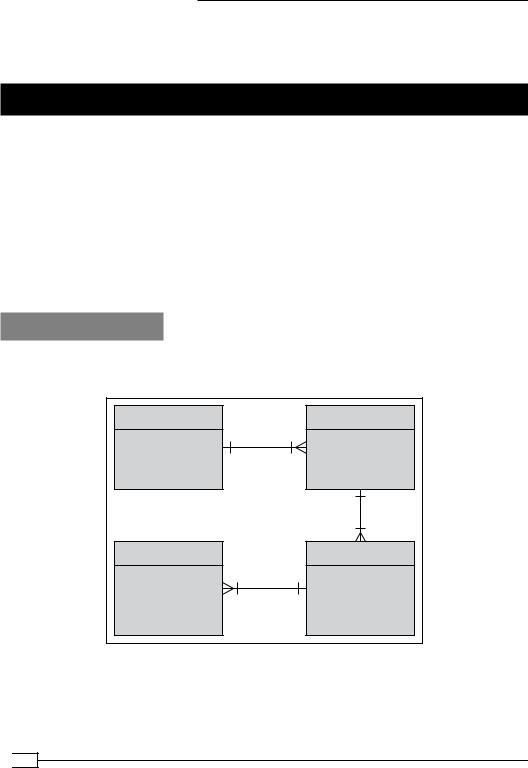
- •Credits
- •About the Authors
- •About the Reviewers
- •www.PacktPub.com
- •Table of Contents
- •Preface
- •Introduction
- •Installing Groovy on Windows
- •Installing Groovy on Linux and OS X
- •Executing Groovy code from the command line
- •Using Groovy as a command-line text file editor
- •Running Groovy with invokedynamic support
- •Building Groovy from source
- •Managing multiple Groovy installations on Linux
- •Using groovysh to try out Groovy commands
- •Starting groovyConsole to execute Groovy snippets
- •Configuring Groovy in Eclipse
- •Configuring Groovy in IntelliJ IDEA
- •Introduction
- •Using Java classes from Groovy
- •Embedding Groovy into Java
- •Compiling Groovy code
- •Generating documentation for Groovy code
- •Introduction
- •Searching strings with regular expressions
- •Writing less verbose Java Beans with Groovy Beans
- •Inheriting constructors in Groovy classes
- •Defining code as data in Groovy
- •Defining data structures as code in Groovy
- •Implementing multiple inheritance in Groovy
- •Defining type-checking rules for dynamic code
- •Adding automatic logging to Groovy classes
- •Introduction
- •Reading from a file
- •Reading a text file line by line
- •Processing every word in a text file
- •Writing to a file
- •Replacing tabs with spaces in a text file
- •Deleting a file or directory
- •Walking through a directory recursively
- •Searching for files
- •Changing file attributes on Windows
- •Reading data from a ZIP file
- •Reading an Excel file
- •Extracting data from a PDF
- •Introduction
- •Reading XML using XmlSlurper
- •Reading XML using XmlParser
- •Reading XML content with namespaces
- •Searching in XML with GPath
- •Searching in XML with XPath
- •Constructing XML content
- •Modifying XML content
- •Sorting XML nodes
- •Serializing Groovy Beans to XML
- •Introduction
- •Parsing JSON messages with JsonSlurper
- •Constructing JSON messages with JsonBuilder
- •Modifying JSON messages
- •Validating JSON messages
- •Converting JSON message to XML
- •Converting JSON message to Groovy Bean
- •Using JSON to configure your scripts
- •Introduction
- •Creating a database table
- •Connecting to an SQL database
- •Modifying data in an SQL database
- •Calling a stored procedure
- •Reading BLOB/CLOB from a database
- •Building a simple ORM framework
- •Using Groovy to access Redis
- •Using Groovy to access MongoDB
- •Using Groovy to access Apache Cassandra
- •Introduction
- •Downloading content from the Internet
- •Executing an HTTP GET request
- •Executing an HTTP POST request
- •Constructing and modifying complex URLs
- •Issuing a REST request and parsing a response
- •Issuing a SOAP request and parsing a response
- •Consuming RSS and Atom feeds
- •Using basic authentication for web service security
- •Using OAuth for web service security
- •Introduction
- •Querying methods and properties
- •Dynamically extending classes with new methods
- •Overriding methods dynamically
- •Adding performance logging to methods
- •Adding transparent imports to a script
- •DSL for executing commands over SSH
- •DSL for generating reports from logfiles
- •Introduction
- •Processing collections concurrently
- •Downloading files concurrently
- •Splitting a large task into smaller parallel jobs
- •Running tasks in parallel and asynchronously
- •Using actors to build message-based concurrency
- •Using STM to atomically update fields
- •Using dataflow variables for lazy evaluation
- •Index

7
Working with Databases in Groovy
In this chapter, we will cover:
ff
ff
ff
ff
ff
ff
ff
ff
ff
ff
Creating a database table Connecting to an SQL database Querying an SQL database Modifying data in an SQL database Calling a stored procedure
Reading BLOB/CLOB from a database Building a simple ORM framework Using Groovy to access Redis
Using Groovy to access MongoDB
Using Groovy to access Apache Cassandra
Introduction
The group of recipes presented in this chapter deals with data persistence, either through a relational SQL database or a NoSQL database.
The first recipe describes how to access and modify data stored in a relational database, such as Oracle or MySQL. Groovy makes accessing data using the SQL language a very elegant affair, compared to the clunky Java's JDBC APIs.
www.it-ebooks.info

Working with Databases in Groovy
The last three recipes show how to use Groovy with the emerging NoSQL databases, such as Redis, MongoDB, and Cassandra. Each of those recipes contains the steps to connect, persist, and retrieve data with one of the three key/value stores.
Creating a database table
As a starting point for this chapter about database access and SQL, we look at how to create a database schema using Groovy. The database model outlined in this recipe will serve as a reference for the rest of this chapter.
The Data Definition Language (DDL) is an essential part of the SQL standard. Through its syntax, it allows defining database objects. These database objects include schemas, tables, views, sequences, catalogs, indexes, and aliases.
Groovy doesn't come with any specific support for this portion of the SQL language.
Nevertheless, we can leverage Groovy's conciseness to simplify the database creation operations.
Getting ready
The following image contains a diagram depicting the tables of the schema we will create in this recipe:
COOKBOOK |
CHAPTER |
ID |
ID |
TITLE |
BOOK_ID |
AUTHOR |
TITLE |
YEAR |
|
INGREDIENT |
RECIPE |
ID |
ID |
RECIPE_ID |
CHAPTER_ID |
NAME |
TITLE |
AMOUNT |
DESCRIPTION |
UNITS |
IMAGE |
As you can notice, the model represents a cookbook which consists of a set of chapters with cooking recipes. Each recipe has a title, detailed description, image of the desired result, and a list of ingredients required to implement it.
 224
224
www.it-ebooks.info

Chapter 7
The database that we are going to use all along is HyperSQL 2.3.0 (HSQLDB) in-memory database. HSQLDB is a very popular database written in Java that is very often used for unit testing and creation of application prototypes—thanks to its lightweight nature.
How to do it...
In order to get started, create a new Groovy script named DBUtil.groovy that will contain some routines that will be used throughout this chapter:
1.Add the following code to the script:
@GrabConfig(systemClassLoader=true)
@Grab('org.hsqldb:hsqldb:2.3.0') import org.hsqldb.Server
class DBUtil {
static dbSettings = [
url: 'jdbc:hsqldb:hsql://localhost/cookingdb', driver: 'org.hsqldb.jdbcDriver',
user: 'sa', password: ''
]
static startServer() {
Server server = new Server()
def logFile = new File('db.log') server.setLogWriter(new PrintWriter(logFile)) server.with {
setDatabaseName(0, 'cookingdb') setDatabasePath(0, 'mem:cookingdb') start()
}
server
}
}
2.In a second script, createDb.groovy, add the following import statements for the DBUtil class and Groovy's SQL utilities to be visible:
import static DBUtil.* import groovy.sql.Sql
225
www.it-ebooks.info

Working with Databases in Groovy
3.We need to define a list of DDL statements we want to run in order to create the database schema. Let's use just a list of strings for that purpose:
def ddls = [
'''
CREATE TABLE COOKBOOK(
ID INTEGER PRIMARY KEY, TITLE VARCHAR(100), AUTHOR VARCHAR(100), YEAR INTEGER)
''',
'''
CREATE TABLE CHAPTER(
ID INTEGER PRIMARY KEY, BOOK_ID INTEGER,
TITLE VARCHAR(100))
''',
'''
CREATE TABLE RECIPE(
ID INTEGER PRIMARY KEY, CHAPTER_ID INTEGER, TITLE VARCHAR(100), DESCRIPTION CLOB, IMAGE BLOB)
''',
'''
CREATE TABLE INGREDIENT( ID INTEGER PRIMARY KEY, RECIPE_ID INTEGER, NAME VARCHAR(100), AMOUNT DOUBLE,
UNITS VARCHAR(20))
'''
]
4.Complete the second script with the following code that executes all the previous SQL statements through a groovy.sql.Sql instance in a loop:
startServer()
Sql sql = Sql.newInstance(dbSettings) ddls.each { ddl ->
sql.execute(ddl)
}
println 'Schema created successfully'
 226
226
www.it-ebooks.info

Chapter 7
5.Assuming that both scripts are in the same folder, launch the createDb.groovy script passing the folder path (or "." if it's a current directory), where both scripts reside to the -cp parameter:
groovy -cp . createDb.groovy
6.The script should print the following line:
Schema created successfully
The script process will continue to run since the database server thread is still active. You can reuse that to connect to the database and perform queries for later recipes (see the
Connecting to an SQL database and Querying an SQL database recipes).
How it works...
In this first recipe, we have covered quite a lot of ground and some explanation is due. The first script contains a utility class to start the HyperSQL server. The database is started with a name (cookingdb) and the path is set to use memory as storage. This means that when we kill the database process, all the data is lost.
Most of the recipes in this chapter can be run against any relational database. After all this is what SQL is about, a vendor-independent language to query data provided that the proper JDBC drivers are available in the classpath.
This is exactly what the @Grab annotation is there for. It fetches the HyperSQL database drivers as well as the server libraries. This is actually an exception, because, in most database scenarios (MySQL, Oracle, etc.) you'd fetch the drivers only and not a full database engine implementation! The @Grab annotation is accompanied by a second annotation:
@GrabConfig(systemClassLoader=true)
This annotation is forcing Grape to place the dependencies in the system class loader. By default, the dependencies are available in the same class loader as our Groovy script or application. But sometimes this is not enough; a typical case is exactly our case, a database driver which is required to be in the system classpath for the java.sql.DriverManager class to access it.
The DBUtil class also contains the database connection settings that we need to access the in-memory database: one those are defined as a Map and contain the standard information required to connect to any relational database, such as the driver or the server host. You will need to adjust all the parameters to newInstance to connect to your database, especially username and password.
The second script, in which the database tables are actually created, is very simple but contains a key class that we will see over and over in the rest of this chapter's recipes, groovy.sql.Sql (see the Connecting to an SQL database and the Querying an SQL database recipes).
227
www.it-ebooks.info
